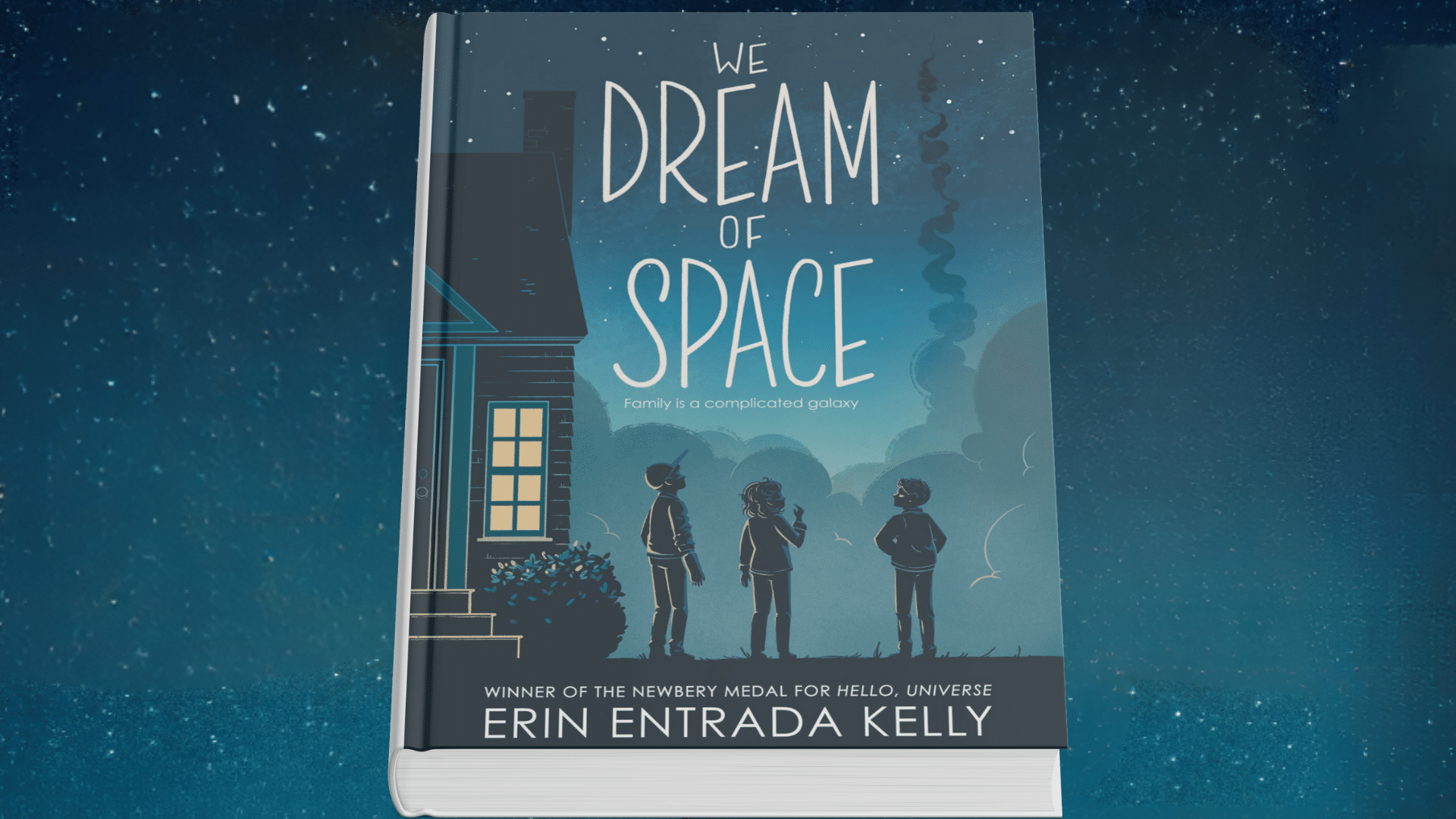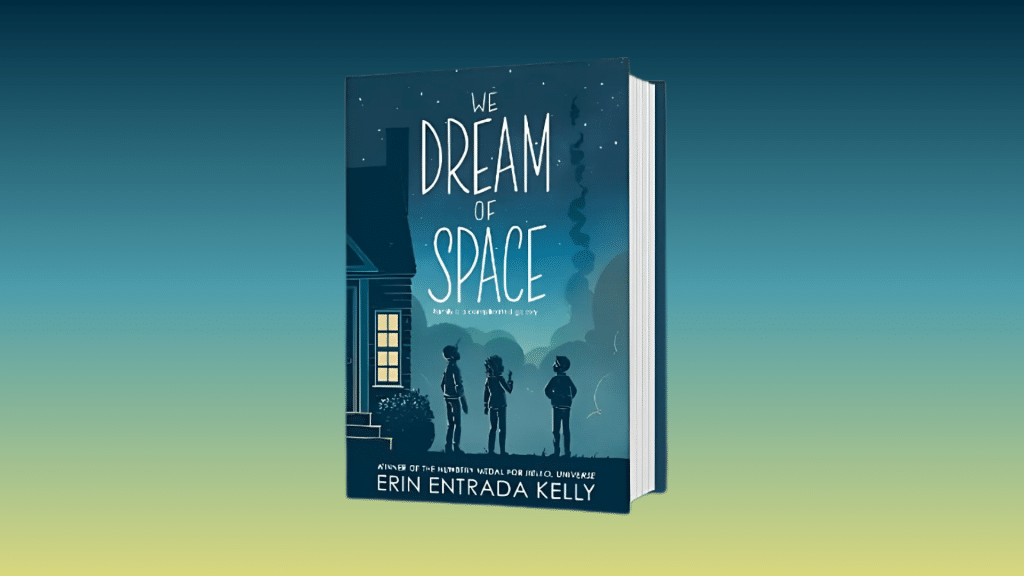What happens when history and family struggles collide? Erin Entrada Kelly answers this in We Dream of Space, a middle-grade novel set in 1986.
The book earned a Newbery Honor and is praised for its moving story and thoughtful characters. At its heart are three siblings – Cash, Fitch, and Bird. Each one faces school pressures, family conflict, and the challenge of finding their place.
Their lives are tied closely to the Challenger space shuttle tragedy, a moment that changed how many children saw the world.
In this blog, I’ll share a full look at We Dream of Space. You’ll find its summary, themes, character analysis, reception, and why it matters for families, classrooms, and book clubs today.
Book Summary of We Dream of Space

We Dream of Space is set in January 1986. The story takes place in a small town during the weeks before the Challenger space shuttle launch.
The story follows three siblings living in a tense home. Their parents argue often, and no one feels truly heard. Cash feels stuck, Fitch feels misunderstood, and Bird feels invisible.
As the Challenger launch nears, Bird’s excitement grows. Her brothers, however, continue to drift through their own struggles. When the disaster strikes, it shakes them all.
The event changes how they see life and each other. It doesn’t solve every problem, but it shows them that family and connection matter more than they realized.
Character Analysis
The story focuses on three siblings who face different struggles. Each one deals with pressure in unique ways, showing how family life shapes identity. Following is the character analysis.
| Character | Strengths | Weaknesses | Symbolism in Story |
|---|---|---|---|
| Cash | Caring, wants to do better | Low confidence, avoids risks, doubts his worth, embarrassed about repeating seventh grade | Represents lost potential when children lack proper support; shows the struggle of feeling stuck when life doesn’t go as planned |
| Fitch | Intelligent, curious about machines | Quick temper, poor control, isolates himself, uses arcade as escape | Shows how anger and outbursts can mask deeper vulnerability and pain |
| Bird | Curious, determined, hopeful, loves science and dreams of space | Feels invisible at home, seeks meaning beyond family struggles | Symbolizes hope, the future, and the dream of space; reflects resilience and imagination |
Themes in We Dream of Space
Erin Entrada Kelly combines family struggles and real history to shape the story. The themes make the novel meaningful for both young readers and adults. They show how personal lives can connect to larger events in powerful ways.
1. Family & Sibling Dynamics
The siblings grew up in a home filled with arguments and distance. Their parents do not pay close attention, and this leaves the children to handle problems alone.
Cash feels weighed down by school failure. Fitch covers his feelings with anger, pushing others away.
Bird escapes into science and dreams of a better future. Together, their stories show how siblings can drift apart yet still share a quiet bond.
2. Dreams and Aspirations
Bird’s dream of space is central to the story. Her love for science keeps her hopeful even when life at home is hard. She imagines a future where she belongs among the stars.
Her brothers focus only on daily struggles, while Bird looks upward. The contrast highlights how dreams can guide people through pain. Big goals may not solve problems, but they give strength to move forward.
3. Communication & Compassion
The family members rarely share their feelings. Silence grows, and anger takes its place. This lack of communication makes each sibling feel alone.
As the story unfolds, the value of compassion becomes clear. Simple acts of kindness help soften anger and open the door to healing. Kelly shows how understanding and listening can change family dynamics, even if problems do not disappear.
4. Historical Impact
The Challenger disaster is not just background—it is a turning point. Children across America looked to the launch with excitement, and Bird was no different.
The tragedy mirrors the siblings’ personal struggles. Just as the nation faced loss, they faced their own disappointments.
It reminds readers that history shapes individuals, and personal growth often comes through shared moments of grief.
Reception, Reactions, and Reader Guide
We Dream of Space has been well received by critics, teachers, and parents. It has earned awards, drawn praise for its writing, and raised some concerns about heavy themes.
Readers generally find it powerful and meaningful, especially for middle-grade students.
| Category | Details |
|---|---|
| Awards | • Newbery Honor – A national award for outstanding children’s books, signaling high quality and respect. • Best Book of the Year – Horn Book – Recognition from a leading children’s literature magazine, showing strong reviewer support. • Best Book of the Year – School Library Journal – Chosen by a trusted source for teachers and librarians, suggesting classroom value. |
| Praise | • Empathetic writing – Each sibling’s feelings are treated with care, helping readers understand their choices. • Clear structure – Short chapters and rotating viewpoints keep the pace easy to follow. • Sensitive handling of the Challenger disaster – Facts are simple, respectful, and mindful of children’s emotions. • Realistic family life – Arguments, silences, and small acts of care feel true to many homes. |
| Critiques | • Heavy family conflict – Frequent tension may upset younger readers; adults may want to check in. • Emotional intensity – Grief and stress appear; breaks during read-alouds may help. • Mild insults – Some name-calling, which can be used as a teaching moment for kinder language. |
Reviews and Reader Reactions
We Dream of Space is praised on Goodreads as moving and thoughtful. Readers highlight the realistic siblings and the careful way the Challenger tragedy is handled, though some feel the family conflict is heavy.
- Many readers call the book thoughtful and moving, especially in how it shows family struggles.
- The Challenger tragedy is handled with care, but can feel heavy for some.
- Common Sense Media finds it best for older kids, with guidance for emotional topics.
- Parents and teachers value it for sparking classroom discussions on family, history, and loss.
- Overall, it is praised as powerful and meaningful, though intense at times.
We Dream of Space: Age Suitability for Readers
The book is best suited for grades 5–8 and is a good match for readers who can handle deeper emotional themes. It gives middle-grade students a chance to find both history and personal growth through storytelling.
Some content may be sensitive for younger readers. Family arguments, mild insults, and the Challenger disaster play key roles in the story, which might feel upsetting for children who are more sensitive.
Even with these heavier themes, the book shines in educational settings. It works well for teaching space history and also supports social-emotional learning by modeling empathy, resilience, and how families cope with conflict.
Conclusion
We Dream of Space is a book that balances emotion and education. It shows how family struggles and history can connect in ways that feel honest and meaningful
The Challenger disaster adds depth while teaching kids about a real event.
The story also offers lessons on empathy, resilience, and dreams. Through Cash, Fitch, and Bird, readers see how children cope with challenges in different ways. This makes the book relatable for both kids and adults.
I recommend We Dream of Space for families, classrooms, and book clubs. It is a strong choice for sparking conversations, guiding discussions about history, and building connections through shared reading.











